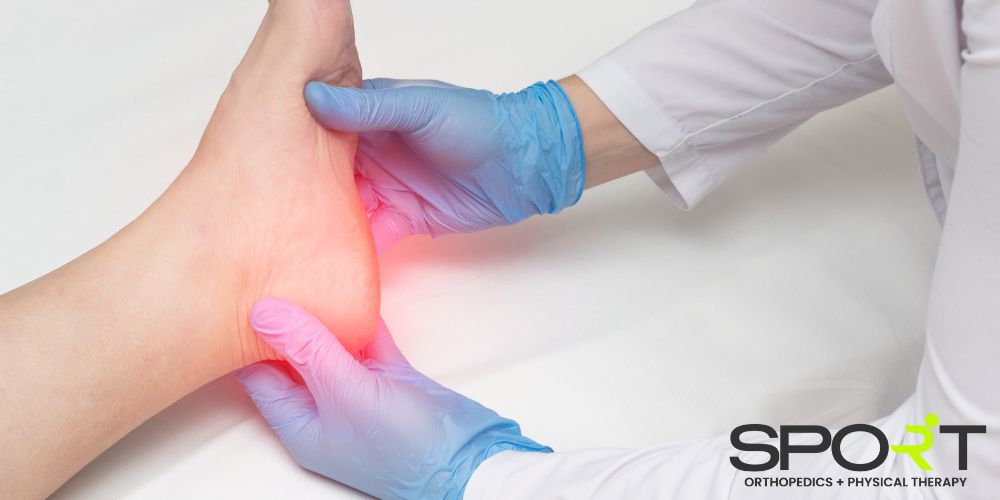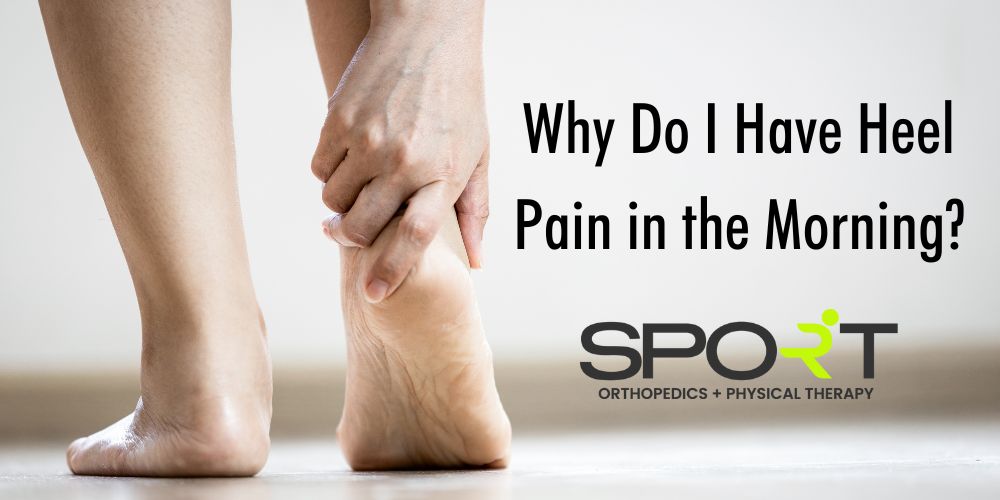Do You Suffer from Morning Heel Pain?
If you’re waking up with heel pain in the morning that disrupts your day, you may be suffering from one of several common conditions. From plantar fasciitis to a heel bone fracture, morning heel pain affects millions of people every year. Luckily, many of the common causes of heel pain can be treated without surgery.
At SPORT Orthopedics + Physical Therapy, our highly skilled orthopedic professionals have extensive experience treating various sources of heel pain. No matter the source of your pain, we can have you back on your feet and back to living your life in no time. To schedule an appointment with us, please call our office at 469-200-2832 today.
What Causes Heel Pain in the Morning?
When people first experience heel pain in the morning, they may assume their heel is just sore from yesterday’s activities. They may decide to wait out the pain for several days, only to realize it isn’t getting any better. In fact, their heel pain may feel worse each day without prompt treatment. If your heel pain does not improve with time, you may be suffering from plantar fasciitis, a stress fracture, heel spurs, or Achilles tendonitis.
Plantar Fasciitis
The plantar fascia is the ligament that runs along the bottom of the foot and attaches to the heel. If the plantar fascia becomes inflamed or damaged, this can cause heel pain. This condition is known as plantar fasciitis. Generally, plantar fasciitis results from repetitive foot motions or placing excess pressure on the foot arch.
While plantar fasciitis pain can happen at almost any time, one of the most common indicators of the condition is heel pain after long rest periods. Heel pain in the morning is particularly common for those with plantar fascia problems. The way that people rest their feet while they sleep can cause the plantar fascia to tighten. The same concept applies after sitting for long periods.
Plantar fasciitis can also flare up during or after exercise, as well as after standing for long periods. This sharp, stabbing pain signals that your foot needs rest and care. Additionally, walking barefoot can actually make your heel pain worse. Wearing supportive shoes is important for minimizing the strain on your feet and lessening your foot pain.
Stress Fractures
The heel bone is also known as the calcaneus. If the calcaneus is fractured from trauma or overuse, this can result in stabbing pain or a dull ache, depending on the severity of the fracture. Heel pain caused by a stress fracture often worsens when bearing weight on the foot, and it may or may not improve with rest. In most cases, stress fractures cause pain that worsens at night, but you could still feel heel pain in the morning.
Remember that if your heels hurt, you should limit your physical activity and seek diagnosis and treatment from a qualified orthopedic specialist. Waiting too long to treat a stress fracture could lead to a complete fracture.
Achilles Tendonitis
Another of the most common causes of heel pain is Achilles tendonitis. The Achilles tendon links the calf muscle to the heel. Its flexibility and strength make the Achilles tendon crucial for walking, running, and jumping. The painful condition of Achilles tendonitis occurs when the Achilles tendon becomes inflamed. This can happen from overuse or from a sudden increase in the intensity or frequency of exercises.
The foot pain from this condition can start as a dull ache that worsens with more activity. This condition usually requires conservative treatments like rest and modifying activities. However, if the Achilles tendon is torn, surgery may be necessary.
Heel Spurs
Although heel bone spurs are not the most common cause of foot pain, they can generate symptoms similar to plantar fasciitis. If the ligaments that connect your toes to your heel are placed under repeated pressure, this can result in bony growths on the heel, called spurs.
Plantar (heel) bone spurs are very common, but only around 5% of those with spurs will experience foot pain as a result. Because many people with heel spurs also have plantar fasciitis, the latter is the more likely source of your pain.
Other Conditions
Certain other conditions can also cause heel pain. Some of these painful conditions include the following.
- Haglund’s deformity
- Heel bursitis
- Rheumatoid arthritis
- Hypothyroidism
How Do I Get Rid of Morning Heel Pain?

Depending on the source and severity of your morning heel pain, you may or may not need treatment. For many people, rest and over-the-counter pain medications are enough to help their pain. If you have mild to moderate heel pain, the following conservative treatment methods may work for you.
Massages and Cold Therapy
Cold therapy with ice can help reduce the swelling and inflammation in your foot. One easy way to approach at-home cold therapy is to fill a plastic water bottle with water, then place it in the freezer overnight. Once the water is frozen, wrap the bottle in a thin towel and roll the cold bottle along your heel in the morning.
Combine cold therapy with home massages to release the tension in your feet and alleviate pain. To do this, use a tennis ball or foam roller to roll along the bottom of your foot from toe to heel. You can also use your thumb to apply gentle pressure along your heel and foot to relieve tension.
Stretching
We also recommend stretching to help alleviate foot discomfort. Focus on stretching your foot arch and plantar fascia in the following ways.
Foot Arch Stretch
Face a wall and take one step back with one foot. Bend the front knee and keep your feet and heels flat on the ground. Lean forward, then hold for 10 seconds. Relax after the hold, then repeat the process with the other leg.
Plantar Fascia Stretch
Sit down on a chair or the side of your bed. Cross the pained foot over the opposite knee, forming the number “4” with your legs. Using the hand on the same side as your affected foot, carefully and gently pull your toes toward your shin. Hold this position for 10 seconds, then relax. Repeat on the other side if necessary.
When to See a Doctor for Morning Heel Pain
If you experience any of the following symptoms, we strongly recommend seeing an orthopedic doctor for your pain.
- Heel pain that lasts throughout the day and interferes with your daily activities
- Heel pain in the morning that does not improve or go away after a few weeks of cold therapy, massaging, and stretching
- Swelling and severe pain around the heel
- Severe pain that occurs after an injury
- Heel pain that occurs alongside swelling, fever, tingling, or numbness
- Difficulty walking normally
Treatments for Morning Heel Pain
After a thorough examination, your doctor will formulate a treatment plan to tackle your symptoms at the source. Some examples of potential treatments for morning heel pain include the following.
- Custom orthotics and supportive footwear
- Corticosteroid injections
- Physical therapy
Surgery is reserved for very severe cases in which other conservative treatments do not help the patient. There are two surgical treatment options for this condition, including the following.
- Plantar fascia release in which the plantar fascia is separated from the heel bone
- Gastrocnemius recession, which lengthens and releases the calf muscle to decrease tightness and relieve tension
Contact SPORT Orthopedics + Physical Therapy Today
If you suffer from stubborn morning heel pain, the orthopedic specialists at SPORT Orthopedics + Physical Therapy are here for you. We offer a wide variety of treatment options for many conditions, including those that cause heel pain. To schedule an appointment with one of the best Dallas orthopedic surgeons, please call our office at 469-200-2832 today.



